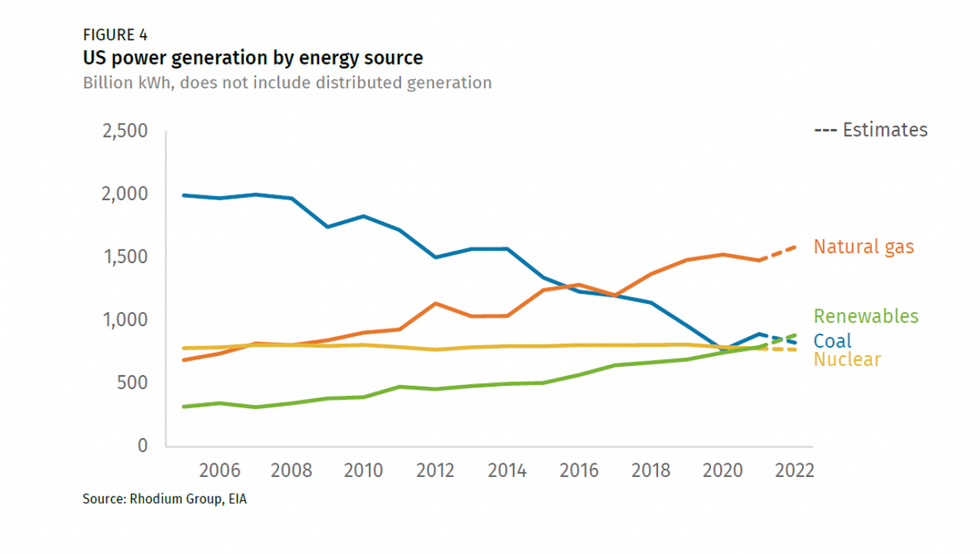For the second year in a row, U.S. carbon emissions increased in 2022—reversing a trend that was evident even before emissions declined significantly in 2020 during the first year of the coronavirus pandemic.
The Rhodium Group, a nonpartisan research firm, released an analysis on Tuesday showing that even though energy produced by renewable sources surpassed coal production last year for the first time in six decades, that advancement wasn't enough to stop U.S. carbon emissions from increasing by 1.3%.
"U.S. emissions had been declining pre-Covid," Pierre Friedlingstein, a climate scientist at the University of Exeter, told The Washington Post. "It wasn't fast enough, but at least it was going in the right direction."
"If we stopped today and didn't make policy adjustments and just relied on the Inflation Reduction Act, we would not make it."
That trend has now been reversed for two consecutive years, The Rhodium Group's preliminary analysis showed.
Wind, solar, and hydropower produced 22% of the nation's electricity in 2022, rising by 12% from the previous year, while coal-powered electricity generated 20%, a slight reduction from 2021.
However, natural gas—which is less carbon-intensive than coal but is a major source of methane emissions—produced far more power than either coal or renewables.
Natural gas generated 39% of total electricity in 2022, up from 37% in 2021. Emissions from homes and buildings rose most significantly in 2022, increasing by 6% from the previous year. About half of U.S. homes use natural gas for heating.

Methane has 80 times more planet-heating power than carbon over a 20-year period, and the growth of natural gas has raised alarm among climate scientists as the warming of the Earth has been linked to disastrous weather patterns such as the long-term drought across the American West and deadly heatwaves in the Pacific Northwest in 2021.
The report released Tuesday offers a "pretty terrible prognosis of U.S. emissions," science writer Ketan Joshi said.
"We are essentially on the same trajectory that we've been on since the mid 2000s," Ben King, author of the report and an associate director at The Rhodium Group, toldThe New York Times, saying the long-term decline in emissions that President Joe Biden has pledged to push forward is "not happening fast enough."
To help the U.S. achieve the goal of reducing its greenhouse gas emissions by at least 50% below 2005 levels by 2030—in order to help limit planetary heating to 1.5°C—the president last year signed the Inflation Reduction Act (IRA) into law. The IRA will provide funding to decarbonize industrial plants as well as incentives for electric vehicle ownership.
"If we stopped today and didn't make policy adjustments and just relied on the Inflation Reduction Act, we would not make it," King toldNBC News. "Additional policy action will absolutely be necessary to achieving those targets."
King said the U.S. must be more aggressive in sharply reducing emissions from the coal sector.
"We're projecting renewables to contribute more to the grid than coal does," King toldthe Post. "From a decarbonization perspective, that's quite an accomplishment, in and of itself. But there's still a meaningful amount of coal left on the system. And for the U.S. to accelerate its decarbonization progress, more of that coal is going to need to go away."
This content originally appeared on Common Dreams and was authored by Julia Conley.
Julia Conley | Radio Free (2023-01-10T16:54:59+00:00) Report Shows ‘Terrible Prognosis’ as US Emissions Continue Rising Amid Climate Emergency. Retrieved from https://www.radiofree.org/2023/01/10/report-shows-terrible-prognosis-as-us-emissions-continue-rising-amid-climate-emergency/
Please log in to upload a file.
There are no updates yet.
Click the Upload button above to add an update.